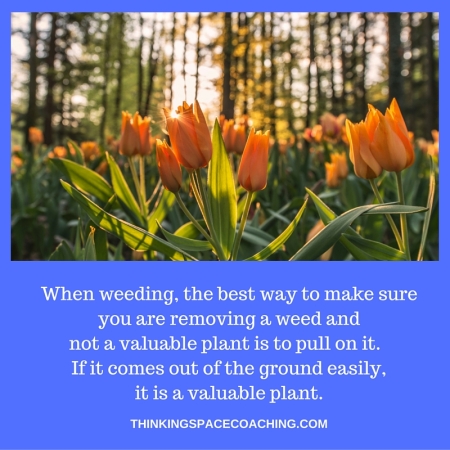I had some time on my hands. The ironing was done; dinner was prepared; the chickens were fed and watered and happily scratching around. It was a sunny afternoon and there was nowhere else I needed to be, nothing else I needed to do. I wandered up the garden to see how the vegetable beds were faring when I noticed that the lettuces and beetroot were being choked by weeds. Grabbing a fork and a bucket, I sat down in the sun and started weeding.
It all went swimmingly well to start with. I was certain that the plant with the little blue flowers didn’t belong there and I knew that we definitely didn’t want chickweed throttling the rocket. I’d soon filled a bucket with the offending weeds and sat back to admire my work.
Then I noticed smaller weeds. I picked up the fork again and resumed my work. Doubt began to creep in: if I looked at a certain angle, it could be said that the ‘weeds’ (I’d already started to put those questioning inverted commas around the word in my mind) were in a straight line. Perhaps these were some tiny lettuces, strangled by the weeds and therefore stunted, a bit like the beetroot? I looked around for a more mature specimen to see if that would give me any clues. Nothing doing – I must have pulled those up with the other weeds. I remembered something I’d once read about weeds:

When weeding, the best way to make sure you are removing a weed and not a valuable plant is to pull on it. If it comes out of the ground easily, it is a valuable plant.
That was it. I didn’t want to risk ripping up something we could eat. I downed tools and decided to wait to ask the garden expert – aka my husband. Later on, he took one look at the mysteriously straight, uncannily lettuce-like plants and decreed ‘yep, they’re weeds’.
I think that sometimes we can get similarly confused when we come to assess our own skills and abilities. It can be easy for us to identify some of the elements of our roles that have just got out of proportion and swamped the really useful work we do. Once we’ve cleared those away, then we start to uncover the skills which are just starting to come into their own. That’s fantastic and a great basis for us when we’re dreaming up our perfect role, working on a CV or a pitch for a new job, or planning our personal and professional development.
Sometimes though, in the excitement of having given our true skills the space to flourish, we can miss those negative elements that are clinging on for dear life: for example, when the weed ‘perfectionism’ has wound its roots around the fruitful ‘attention to detail’. It could be worth you asking someone else to help you work through your working and learning styles, allowing you to fully identify your attributes as well as those elements which could be holding back your performance.
That person could be a trusted colleague, your line manager, your company’s training manager, a good friend or it could be your coach. I felt a little silly that I couldn’t tell the difference between a plant and a weed: don’t let that stop you from asking someone to help you do the same with your performance.
Today’s pebble for you to consider:
How do you tell the difference between the plants and the weeds in your work and life?
Michelle
Turning over pebbles is the blog of Thinking Space Coaching.
If you’d like to make progress in your work and life, why not email me to see how we can work together?

I wish I could identify the weeds earlier! Sometimes the weeds are recognisable because they have distinctive early characteristics. Often though, the early leaves look somewhat similar to something I intended to grow. Or they’re new and strange and I let them grow to see what they might be… only to find that they’ve choked what I wanted. To answer the question though: I tell the difference by their fruit: what it is that they produce? Is it good and wholesome and true and lovely? Is it productive, edifying, profitable, generous, healthy?
And to answer in another way: I can sometimes tell by what I have sown. If I’m honest, sometimes I’m aware that the seeds I’m sowing into a relationship or activity at work are bindweed rather than morning glories!
Looking at the fruit they produce sounds like an excellent idea!
Thank you for commenting,
Michelle